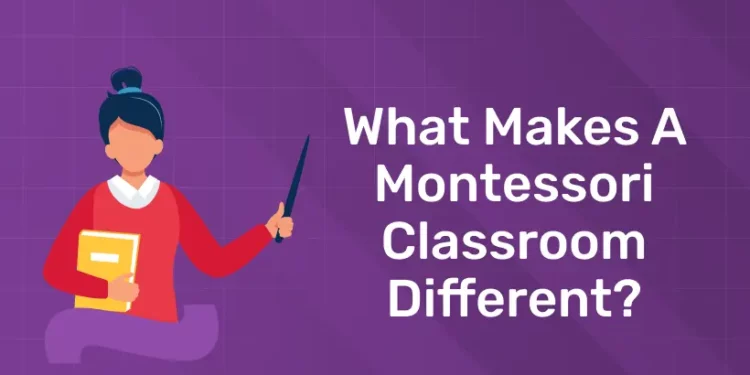Table of Contents
Montessori education is not wholly distinct from traditional education. The theories of Dr. Maria Montessori have had a significant and expanding impact on education all throughout the world over the past century. Notwithstanding the fact that specific components of her curriculum are yearly making their way into more conventional classrooms, schools that fully adopt the Montessori approach provide a significantly different result overall. In this article we are discussing about how a montessori classroom different from others.
Start now to become a certified Montessori teacher! Get free Demo Here!
What Makes A Montessori Classroom Different?
-
Multi-age education
Instead of dividing students by year, Montessori classrooms are divided into multi-age, three-year groups. It follows that learning occurs organically in relation to a child’s development rather than based just on age. For instance, students in the classroom for 3-6 year olds navigate a common area known as The Children’s House. For the early years, when learning occurs best when a youngster has the chance to take in their environment, it is specially designed. It is not expected that youngsters will learn at the same rate. When the younger kids witness firsthand the sophisticated work that the older kids get to accomplish, it inspires them to keep going. As they take on significant leadership positions and enjoy lending a helping hand to their younger colleagues, the older kids are consolidating what they have learnt.
-
Independence
Students select assignments that pique their interest throughout the day and take as much time as necessary to finish them. Students are not required to sit at designated desks or tables; instead, they are free to walk throughout the classroom, selecting their work as well as the location and person they want to work with. Students are urged to rely on one another for assistance and to use their problem-solving abilities to overcome obstacles. Adults don’t talk back to pupils or interrupt them unless they really need help. Pupils are granted “freedom with responsibility,” meaning they can have as much independence as they can manage in a responsible manner. Elementary school pupils use their guides to create goals, and they are in charge of keeping track of their progress toward those goals and documenting their work.
-
Directing for self exploration
A Montessori educator plays a distinct role than a teacher with traditional training; they are referred to as guides. The children’s learning is not controlled by the guide, who stands at the front of the room. Rather, the carefully thought-out arrangement that encourages self-directed inquiry is what extends the offer to learn. Long, unstructured work periods where kids are allowed to select their own topics of interest are protected by the guidance. The guide goes with the kids, constantly observing, interacting with, and supporting each child’s interests, problems, and abilities. A teacher’s desk is never present in a Montessori classroom. A Montessori guide is an expert in teaching by example rather than by lecture, having received specific training in this area.
-
Organization with a sense of community
Children are allowed to engage and participate in the classroom community in a way that promotes independence and community in Montessori classrooms. Children acquire lessons in Practical Life, Grace, and Courtesy starting at age 6, which promotes dignity and delight in learning. Because they are allowed to participate without worrying about making errors, Montessori children encourage inclusivity and self-belief in themselves. By elementary, middle, and high school, extracurricular programs like Life Design, Creative Expressions, and Physical Expressions combine social interests with practical life skills, enticing students to organize field trips and work with companies and artists. This independence fosters original thought and inventiveness.
-
Protected focus combined with practical education
In a Montessori classroom, note memorization is not how a kid learns. As an alternative, children learn by doing in Montessori classrooms, which place a strong emphasis on experiential, hands-on learning. This is valid across the board for all subject areas, including math, language, and cultural studies. The purpose of the Montessori educational tools is to include the child’s hands in order to produce long-lasting, tangible imprints of abstract ideas that support knowledge retention as opposed to merely acquisition.
Self-correcting materials are used in hands-on learning activities in Montessori classrooms, which go beyond simply keeping kids occupied. The goal is to preserve the children’s motivation. When an activity includes built-in error control—like a puzzle that fits together only in a certain way—a parent or other adult does not need to intervene to help the child troubleshoot because the activity itself is self-correcting. For this reason, in addition to having tangible tools at their disposal, a Montessori student also benefits from not having to worry about extra monitoring when it comes to those crucial moments of focus and problem-solving.
-
Self Construction
The universe, the solar system, our planet, our continent, and other global perspectives are the focal points of instruction in Montessori education. This is expanded upon at the elementary school level through the use of the Cosmic Curriculum. Every year, the children are introduced to the cosmos through the five Great learning, which set the stage for all other learning. With this wide-ranging viewpoint, children learn to consider themselves to be global citizens. For Montessori pupils, getting good marks, being well-behaved, or getting into a good college are not the ultimate goals of education. They are raised with a type of schooling that helps them build a better version of themselves, which benefits society as a whole.
Achieve your dream of becoming a teacher! Join Montessori Course Now!
-
Growth of the entire child
Since social and emotional development is viewed as a lifetime process, a montessori trainer play a crucial role as role models for students in the classroom. True discipline, in Maria Montessori’s opinion, emanates from within rather than from a superior. In order to honor this evolving moral compass, Montessori educators never employ fast fixes or extrinsically driven strategies like rewards systems, spankings, or bribes. Rather, a youngster is guided in what is expected of them and what is decent, fair, and right in a logical and courteous manner.
All behaviors are seen as a form of communication, and guides assist kids in finding the underlying causes of actions that are judged inappropriate in order to help them revert to a calm condition. Guides provide an example of respect by never viewing a youngster as less than human and never treating them as mindless followers. Kids pick up good behavior because they have witnessed and experienced what feels right in a secure, developmentally appropriate environment, not because an adult “said so.” Additionally, they have received practical tools to help them recognize, understand, and deal with the range of emotions that all people experience throughout their lifetimes.
Entri’s Montessori Teacher Training Course
1: What is the primary focus of the first plane of development in the Montessori method?
Being certified by the appropriate organization can make all the difference in pursuing a happy career as a Montessori teacher. With the goal of giving its students the tools they need to be successful in the field of Montessori education, Entri App offers the best Montessori Teacher Training Course. The curriculum is well-structured. Details about fees can be obtained by contacting Entri App.
Get Certified & Start Your Montessori Career
Montessori Teacher Training Course by Entri App: Gain expert skills, earn certification, and kickstart your teaching career.
Join Now!CONCLUSION
Helping kids reach their full potential is the main objective of a montessori education that the aforementioned factors support together. Every child learns universal knowledge in a way that has meaning for them in a Montessori classroom, which is organized for the unstructured.











